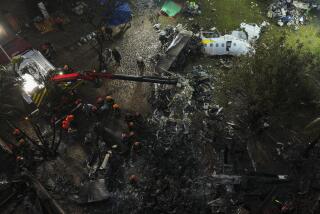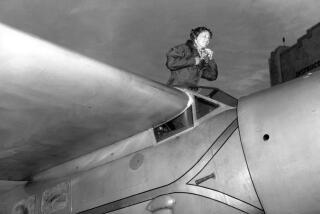Deep seas stand between crash experts and answers
- Share via
If there is ever to be an answer to what caused Air France Flight 447 to fall from the sky, the best clues probably lie on the floor of the Atlantic Ocean amid rugged volcanic ridges and steep trenches, some plunging deeper than the Grand Canyon.
Search planes scouring the area Tuesday spotted a seat, an orange buoy, a tank and a fuel slick about 400 miles off the Brazilian coast. Brazilian authorities identified them as pieces from the Airbus A330 that disappeared late Sunday, and French officials reiterated that there was virtually no chance that any of the 228 people aboard survived.
Most of the wreckage is probably resting now 9,000 feet to 14,000 feet below the surface, where it is pitch black, the water temperature is 40 degrees and the pressure as high as 7,000 pounds per square inch, scientists said.
Investigators will have to send robotic submarines into this hostile environment to look for crucial pieces of evidence in the disappearance of the Paris-bound flight.
A battery-operated sonar “pinger,” 4 inches long and about an inch in diameter, should already have started sending out acoustic signals from the ocean bottom about once every second. The pinger is attached to the flight data recorder, which is embedded in the rear section of the jetliner’s fuselage. Another pinger is attached to the cockpit voice recorder.
Even with the help of those homing signals, the task of finding the debris amid the rugged seascape will not be easy, experts said. And if searchers find them, they will face challenges reaching the wreckage and determining what happened.
“You want to treat it like a crime scene, taking detailed photographs,” said Dave Gallo, director of special operations at Woods Hole Oceanographic Institution in Massachusetts. “In the past, the urge was to remove evidence as quickly as possible, but before you disturb anything you want a detailed survey.”
The floating debris was spotted north of the archipelago of Fernando de Noronha off the Brazilian coast, suggesting that the plane disappeared not long after it last radioed its position.
But wind and ocean currents may have pushed the floating debris miles from the impact point in the intervening day, and it will be difficult for investigators to pinpoint the location of the most important pieces of evidence, the two so-called black boxes that record flight data and the voices of the pilots.
Brazilian air force Col. Jorge Amaral offered another explanation for why debris might be found slightly off the scheduled flight path. The pilots might have been attempting to make a turn, he said, acknowledging that his theory was only speculation.
The search crews have about 30 days before the batteries on the homing devices run out, said Thomas A. Greenacre, president of Dukane Corp.’s Seacom Division, the largest supplier of acoustic homing devices.
“It is at an extreme depth,” Greenacre said. “The location and recovery will be very difficult.” He said the beacons aboard the Airbus A330 were probably made by Dukane, but he could not be certain.
Plane crash investigations have recovered data from deep waters, but seldom at the depths that will be encountered in the case of Flight 447.
Most of the wreckage, as well as many human remains, were recovered from TWA Flight 800, a Boeing 747 that crashed off Long Island in 1996. But that plane sank in water only 120 feet deep, and at that depth divers were able to help.
Wreckage of the space shuttle Challenger and the remains of the astronauts were recovered off the Florida coast at a depth of less than 1,000 feet in 1986.
Debris from the crash of the small plane that took the life of John F. Kennedy Jr. nearly a decade ago was recovered from the Atlantic, but again from relatively shallow waters.
In 1987, a South African Airways 747 crashed into the Indian Ocean off the island nation of Mauritius, sinking to a depth of about 16,000 feet. After an unsuccessful two-month search by the South African military, the U.S. Navy was able to locate the wreckage and the cockpit voice recorder. The accident was eventually blamed on cargo that caught fire.
The wreckage of the Air France jetliner probably will contain much of the information that will be crucial to determining the cause of the crash, which occurred in a violent thunderstorm.
Search planes and ships converged on the area Tuesday, but clouds and more storms complicated their efforts.
Reaching any conclusion will require a wealth of data about the flight parameters, engine condition and discussions in the cockpit. Investigators will need to determine whether the wreckage shows any sign of an explosion and whether the aircraft broke apart before hitting the water.
The first step in getting that information will involve sending crews to the most likely impact point, where they will lower hydrophones into the water and attempt to pick up the homing signals. They will try to pinpoint the spot in the ocean directly over the wreckage, said Laurence Madin, director of research at Woods Hole.
The area of the crash is on the western flank of a mostly undersea mountain range called the Mid-Atlantic Ridge, which runs roughly north and south down the middle of the Atlantic. It was formed by plate movements and volcanoes, creating a geology of hard dense rock. It will make sonar operations particularly difficult, creating “shadows” in the signals that could mask the wreckage, Gallo said.
Once the wreckage is located, investigators probably will want detailed photographs of the debris field on the ocean floor before any recovery operations begin.
Only a few nations have the deep submersible vessels that can go to 14,000 feet. Woods Hole just sent one of its new robotic craft to the bottom of the Mariana Trench in the Pacific, the deepest place in any ocean on Earth -- more than 35,000 feet.
The Alvin, owned by the U.S. Navy and operated by Woods Hole, can send a crew of three down to about 17,000 feet, but, at least initially, investigators probably will opt for a robotic craft for safety.
The robotic craft are connected to a mother ship by a fiber-optic umbilical cord, feeding video of the undersea scene. The craft has manipulator arms that can use tools to cut into the fuselage and extract the flight recorders.
The bigger question is whether French investigators will attempt to salvage the entire aircraft wreckage, as was done in the case of the TWA accident, and the remains of the passengers.
ralph.vartabedian@ latimes.com
Special correspondents Marcelo Soares in Sao Paolo, Brazil, and Chris Kraul in Bogota, Colombia, contributed to this report.
More to Read
Sign up for Essential California
The most important California stories and recommendations in your inbox every morning.
You may occasionally receive promotional content from the Los Angeles Times.














